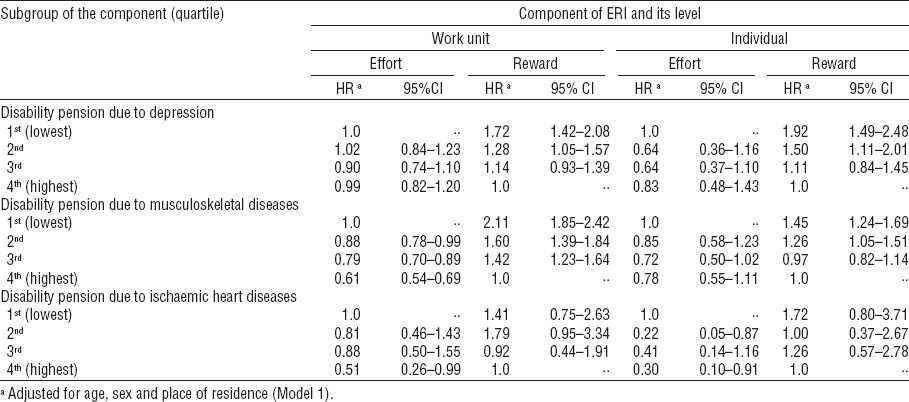As the large post-war generations reach the pension age, most OECD nations are facing a pension crisis phenomenon known as the “grey tornado” (1, 2). Given increasing life expectancy (1) and currently low birth rates (2), the old-age dependency ratio (people aged ≥65 in relation to people aged 15–64 years) is growing (1, 2), resulting in less people in the labor force than those who are economically inactive (ie, the retired, the unemployed). Disability pension is a common pathway to preterm exclusion from the labor market among those of an economically active age (3). Therefore, reducing the high amount of disability pensions is considered a potential policy for overcoming the pension crisis (1, 3). Improving psychosocial working conditions, for example by reducing work stress, is supposed to decrease the incidence of stress-related illnesses (such as depression) (3) and thus be helpful in preventing disability pensions (3).
The two leading work stress models, the job strain and effort–reward imbalance (ERI) models, propose that stress at work – ie, an imbalance between job demands and control or efforts and rewards at work – is harmful to employees’ health (4, 5). Previous reviews and meta-analyses have found that employees experiencing work stress, defined by job strain or ERI, are at an increased risk of mental disorders (depression in particular) and ischemic heart diseases (IHD) (6–12). Earlier studies also suggest associations between job strain or ERI and musculoskeletal diseases, although the findings have not been entirely consistent (13–15). Depression and musculoskeletal diseases are the two leading causes of disability pensions worldwide (3, 16, 17). High job strain has been shown to associate with all-cause disability pension (18–20), while as regards diagnosis-specific disability pension, consistent associations have been found with disability pension due to musculoskeletal diseases, although not with depression or coronary heart disease (21). High ERI or the components of ERI (ie, efforts and rewards) have been associated with ill health-related early exit from working life (22), early-retirement intentions (23), and all-cause disability pension (24). However, no longitudinal study has examined the association between ERI and diagnosis-specific disability pension.
Using a large prospective cohort of public sector employees, we examined the association between ERI and subsequent diagnosis-specific disability pensions. Our study end-points were disability pension due to depression and musculoskeletal diseases (two leading causes of disability pension associated with ERI) (6–17) and IHD. IHD was included because the evidence on the association between work stress and coronary heart diseases is consistent (12). In addition to self-assessed ERI, we used aggregated work unit-level scores to measure ERI, an effective way to maximize the independence between the exposure and the outcome (9, 21, 25–27).
Methods
Study sample and design
The ongoing Finnish Public Sector Study comprises employees working in the service of ten towns and six hospitals districts in Finland. The Ethics Committee of the Hospital District of Helsinki and Uusimaa approved the study. In the present analyses, all employees who had a work contract for ≥6 months in the target organizations in 2000–2002 (N=71 705) were included. In 2000–2002, 48 598 employees responded to a survey on psychosocial factors and well-being at work, including efforts and rewards (response rate 68%). These responses were used to construct aggregated work unit-level scores of ERI for all eligible employees (N=71 705). By using work unit-level exposures, we were also able to include those who did not respond to the survey (N=23 107) in the analyses. Of the 71 705 eligible participants, we excluded those who were on a long (>90 days) sick leave or retired or deceased at the beginning of the follow-up (N=1041). Participants from two large hospital districts in Central and Northern Finland, where ERI was not measured (N=10 185), and participants with missing data on baseline covariates (N=1730) were also excluded. Finally, because work unit-level ERI might become biased if based on responses of only one or two employees, we excluded participants from work units with less than three respondents (N=6875) on questions of ERI, leaving 51 874 employees [75% women, aged 44.3 (range 17.0–64.0) years on average at the baseline] in the analytic sample. In addition, a subsample of the analytic sample consisting of the survey respondents (N=35 260) was used to study the association of individual-level ERI with disability pension.
We used employers’ records to identify the work unit code for each employee. Personal identification codes, which are assigned to all citizens in Finland, linked participants to their records in national pension, health and death registers from 1994–2010. The linkage to registers was successful for employees living in Finland but not for the 0.27% of employees who had moved abroad. The follow-up began on 1 January following the survey year and ended when the participant was granted disability pension (study end-point), old age pension, if s/he died, or 31 December 2010, whichever came first.
Individual-level effort–reward imbalance
As in our earlier studies (28), four survey questions [one on efforts and three (Cronbach’s α=0.64) on rewards] adapted from the standard 10-item ERI scale developed by Johannes Siegrist (29) were used to assess individual-level ERI (appendix A, www.sjweh.fi/data_repository.php). The response format was a 5-point Likert scale (1=strongly disagree, 2=disagree, 3=neither agree nor disagree, 4=agree, and 5=strongly agree) and greater values indicated greater effort or rewards. The ratio of the self-assessed effort score and the mean of the self-assessed reward scores formed the individual-level ERI (ie, individual level ERI=self-assessed effort/mean of self-assessed rewards). A higher ratio score indicated greater individual-level ERI.
Validation of short measure
The standard 10-item ERI scale was used in Finnish Public Sector Study once, in the 2010 survey. We tested the validity of our 4-item (the short ERI) measure on those participants (N=18 928), who (in addition to the survey in 2000–2002) had also participated in the survey in 2010 and thus responded to both ERI (the standard and the short) measures in 2010. Using Pearson’s correlation coefficients, we found a moderate correlation between the short and standard ERI measures (R=0.57, P<0.001).
Work unit-level ERI
We used employers” administrative records to determine 3221 functional work-units with at ≥3 survey respondents. These functional units were at the lowest organizational level and at a single location (eg, a school or a hospital ward). The mean size of these work units was 18.8 (range 3–672) person-years. Each participant was connected to a relevant work unit and, for each unit, a mean score of all individual-level ERI scores within the same work unit was computed. This mean score was set as a work unit-level ERI score and linked to each employee in the same work unit. Thus, all employees in the same work unit were given the same work unit-level ERI score, regardless of their survey response status or own survey responses. The intra-class correlation (ICC) for work unit-level ERI was 5%, indicating moderate variance in ERI between work units.
Disability pension
Data on disability pensions were obtained from the Finnish Centre for Pensions, which coordinates all earnings-related pensions for permanent residents in Finland. All gainful employment is insured in a pension plan and accrues a pension. The starting dates of disability pension (fulltime, partial, and fixed-term or permanent) and the main diagnosis according to the International Classification of Disease, 10th edition (ICD-10) were obtained for all participants, regardless of employment status or workplace at follow-up. Disability pensions due to depression (ICD-10 codes F32-F34), musculoskeletal diseases (ICD-10 codes M00-M99) and IHD (ICD-10 codes I20-I25) were chosen as study outcomes. Participants who retired or died were censored.
Covariates
Covariates included baseline sociodemographic factors (age, sex, place of residence, occupational status, education, and income), baseline physical and mental health, and work-related characteristics. Age, sex, place of residence (Southern, Central, or Northern Finland), and occupational status (higher non-manual, lower non-manual, and manual; based on the classification of the Statistics Finland) (30) were obtained from the employers” registers. Education (primary, secondary, or tertiary) and income (based on the size of residence) (31) were obtained from national registers (Statistics Finland’s Education register and the Building information register of the Population Register Centre).
Baseline physical illness (yes/no) was based on eligibility for special reimbursement of medication (for diabetes, asthma, hypertension, cardiac insufficiency or coronary heart disease) at baseline or a cancer diagnosis within the five years preceding the beginning of the follow-up. Baseline mental disorders (yes/ no) was based on recorded (within the survey year or the three preceding years) long-term sick leave due to mental disorders (>90 days due to ICD-codes F00-F99), hospitalization due to mental disorders (ICD-10 codes F00-F99), reimbursement for psychotherapy, antidepressant use [purchases equal to ≥3 months of an efficient dose of antidepressant medication, Anatomical Therapeutic Chemical (ATC) code N06A], or recorded (at baseline) special reimbursement for antipsychotic medication. Information on special reimbursement for medication and psychotherapy as well as information on antidepressant use was obtained from the national registers of the Social Insurance Institution of Finland, information on cancer from the Finnish Cancer Registry and information on hospitalization from the Hospital Discharge Register.
Work-related characteristics at the individual level were the type of job contract (permanent or fixed-term) and the type of employer (hospital district or municipality); at the work unit-level, characteristics included the size of the unit, mean age of employees, and the proportion (%) of temporary employees in the participants’ work unit (32) as well as work unit-level job strain. All work-related characteristics, except for job strain, were drawn from the employers’ registers. For survey respondents, an individual-level job strain score was calculated from their responses to the baseline questionnaire (including questions on job demands and control derived from the Job Content Questionnaire) by using a subtraction model (for details, see 21). We further calculated an aggregated work unit-level job strain score for each participant by using mean scores of all individual-level job strain scores from the same work unit. Work unit-level job strain was chosen as the baseline covariate, since we have previously found an association between job strain and disability pension due to musculoskeletal diseases (21). However, although the ERI and job strain models are related, especially as regards the efforts and the psychological demand components, they also differ. Therefore, we hypothesized that ERI would have an independent association with disability pension.
Statistical analysis
Mean values and standard deviations (SD) of work unit-level effort, reward, and ERI in relation to baseline covariates were used to describe the association of covariates with ERI and its components. For the main analyses, work unit-level and individual-level ERI scores were divided into quartiles. The cut-off points for work unit-level ERI were 0.991, 1.428, 1.554, and 1.688; and 0.200, 1.210, 1.440, and 1.800 for individual-level ERI. The lowest quartile was used as a reference for hazard ratios (HR) and their 95% confidential intervals (95% CI) for the disability pension risk estimated by the Cox proportional hazard models. In addition to diagnosis-specific disability pension due to depression, musculoskeletal diseases, and IHD, we ran subsidiary analyses for all-cause disability pension. The analyses were conducted in two steps. Model 1 included demographic factors (age, sex, and place of residence) and Model 2 (fully adjusted model) additionally included socioeconomic status (occupational status, education, and income), baseline health and work-related characteristics (type of employer, type of work contract, size of the work unit, mean age of employees in the work unit, proportion of temporary employees in the work unit, and work unit-level job strain). Using crude models and continuous ERI, the sex differences for the risk of disability were tested by entering the term sex×ERI to the models, including the main effects of sex and ERI. No interaction between sex and work unit-level ERI was found (P=0.1–0.8), thus we did not stratify by sex.
The associations between the work unit- and individual-level components of ERI (ie, effort and reward) and cause-specific disability pension were also studied. For these analyses, work unit-level efforts and rewards and individual-level rewards were divided into quartiles. The cut-off points for work unit-level effort quartiles were 1.33, 4.01, 4.22, and 4.36. Based on one question only, the distribution of individual-level effort (range 1.00–5.00) was strongly distorted. In order to create a four-class measure for individual-level effort, we connected values 1 and 2 to form the lowest (1st) class of individual-level effort and set the other self-assessed values for efforts (values from 3–5) as 2nd, 3rd, and 4th (highest) classes of individual-level effort. As regards rewards, the cut-off points were 1.00, 2.67, 2.87, and 3.06 for work unit-level reward quartiles; and 1.00, 2.50, 3.01, and 3.5 for individual-level reward quartiles. SAS statistical software, version 9.2 (SAS Institute Inc, Cary, NC, USA) was used for all analyses. Multivariate adjusted HR were calculated using the PHREG procedure.
Results
A high level of effort at the work unit level was found among upper non-manual employees and among participants with tertiary education. In addition, participants who worked in units with a high percentage of temporary employees had high levels of work unit-level effort (table 1). A low level of reward at the work unit level was observed among male and manual employees and participants with primary or secondary education. Low levels of reward were also found among participants with high levels of job strain in the work unit and those who worked in large work units or units with a low percentage of temporary employees (table 1).
Table 1
Baseline Characteristics of the sample. [ERI = effort-reward imbalance; SD= Standard deviation].
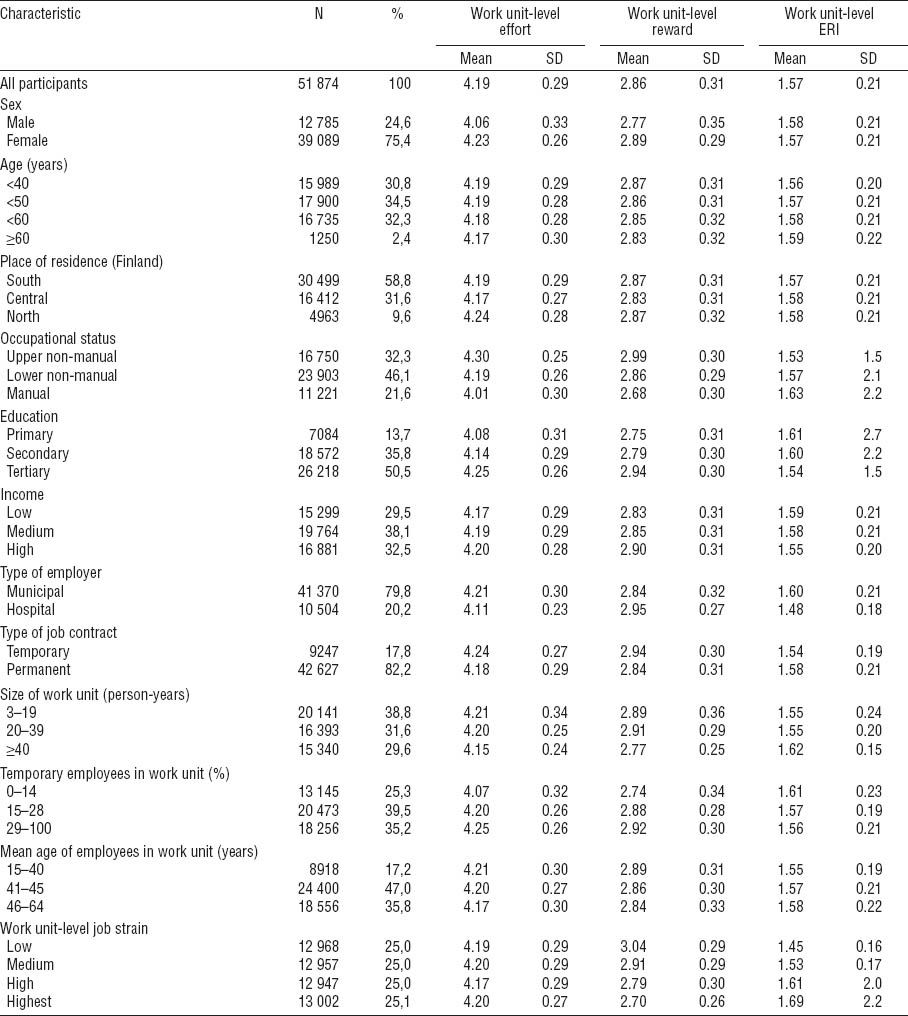
During a mean follow-up of 8.9 years, 4642 employees were granted disability pension (table 2, appendix B, www.sjweh.fi/data_repository.php). Of these, 890 (19%) were due to depression, 2001 (43%) due to musculoskeletal diseases, and only 87 (2%) due to IHD (table 3). Model 1 (adjusted for age, sex, and place of residence) showed an association between work unit-level ERI and all-cause disability pension, but no association was found in the fully adjusted model (table 2). However, high individual-level ERI was associated with a 1.3-fold risk (HR 1.33, 95% CI 1.20–1.47) of all-cause disability pension in the fully adjusted model (table 2).
Table 2
Work unit‐and individual‐level effort‐reward imbalance (ERI) and all-cause disability pension. Hazard ratios (HR) and their 95% confidence intervals (95% CI) derived from Cox proportional hazard models.
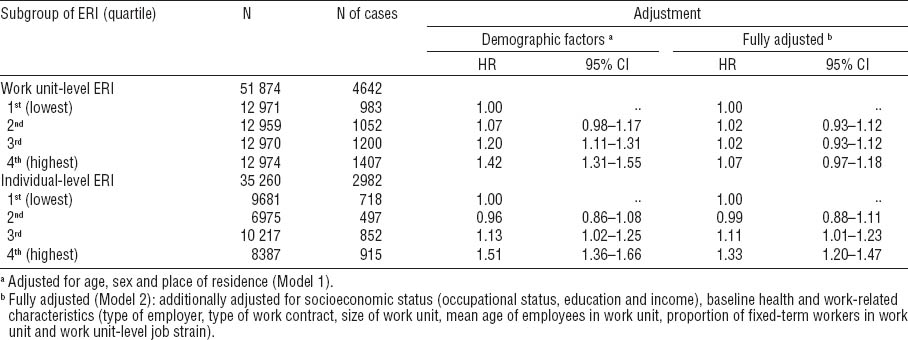
Compared to their counterparts working in units with the lowest level of ERI, employees with the highest work unit-level ERI were at a 1.7-fold risk (HR 1.68, 95% CI 1.39–2.03) of disability pension due to depression when adjusted for age, sex, and place of residence (table 3). The estimate changed only slightly in the fully adjusted model (HR 1.63, 95% CI 1.31–2.04). High individual-level ERI also associated with an increased risk of disability pension due to depression, irrespective of adjustments (HR 1.90, 95% CI 1.51–2.40 in the fully adjusted model) (table 4). The cumulative incidence of disability pension due to depression by ERI quartiles is shown in figure 1, which illustrates the proportions of participants (0–30%) in each ERI quartile who were granted disability pension due to depression over a certain amount of time (0–10 years) after baseline. These hazard curves diverged from each other, as expected, throughout the entire follow-up period (log-rank test, P<0.0001).
Table 3
Work unit-level effort-reward imbalance (ERI) and cause-specific disability pension. Hazard ratios (HR) and their 95% confidence intervals (95% CI) derived from Cox proportional hazard models.
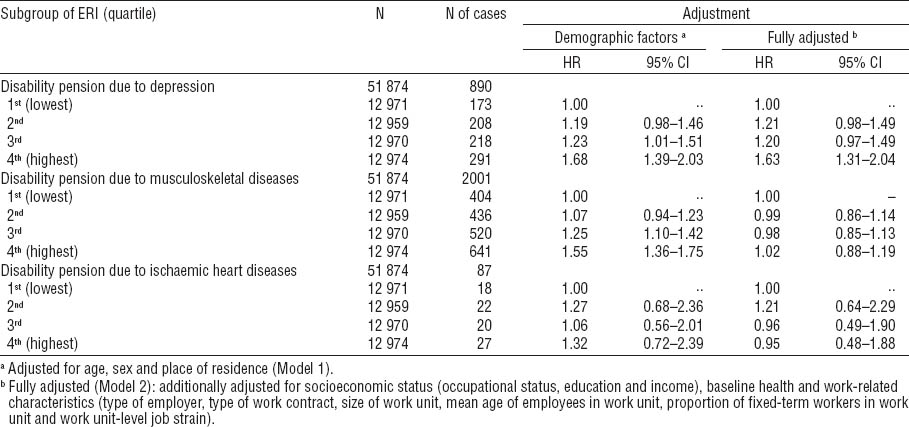
Table 4
Individual-level effort–reward imbalance (ERI) and cause-specific disability pension. Hazard ratios (HR) and their 95% confidence intervals (95% CI) derived from Cox proportional hazard models.
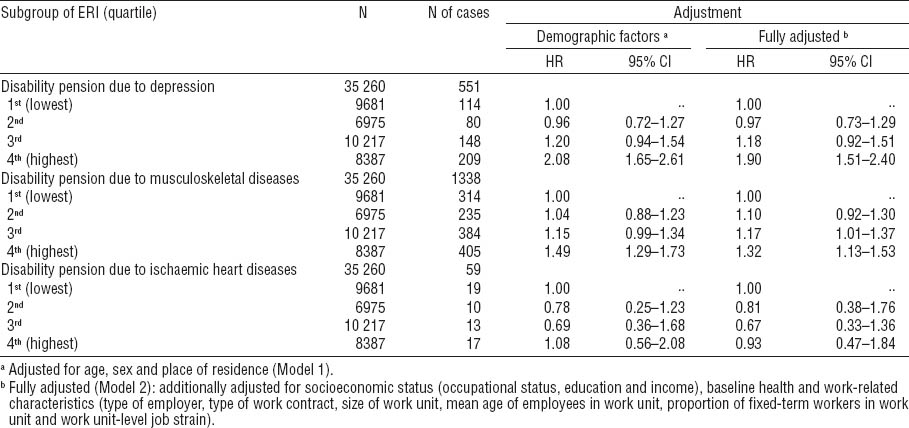
Figure 1
Cumulative hazard curves of disability pension due to depression by quartile of work unit-level effort–reward imbalance.
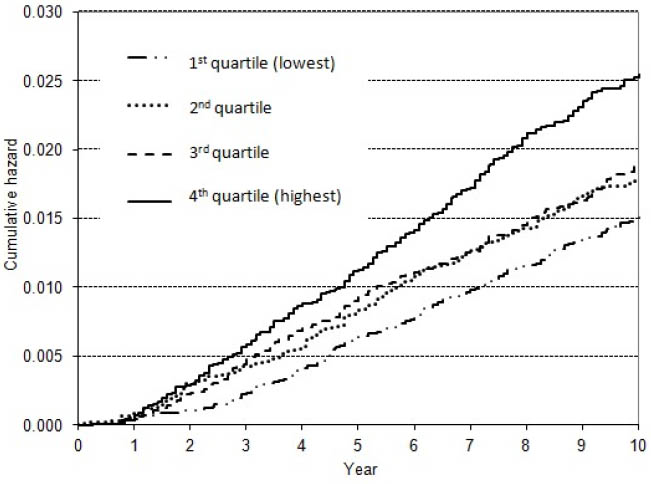
Adjusted for demographic factors, high work unit- and individual-level ERI were associated with a 1.5–1.6-fold (HR 1.55, 95% CI 1.36–1.75: work unit and HR 1.49, 95% CI 1.29–1.73: individual) risk of disability pension due to musculoskeletal diseases. However, after adjustment for all covariates, the effect size for the association of individual-level ERI was only slightly smaller (HR 1.31, 95% CI 1.13–1.53), but the association of work unit-level ERI totally attenuated (HR 1.02, 95% CI 0.88–1.19) (tables 3 and 4). No association was found between ERI (either level of measure) and disability pension due to IHD (Tables 3 and 4).
As regards the individual components of ERI (ie, effort and reward) we found that low reward, both at the work unit and individual level, was associated with an increased risk of disability pension due to depression and musculoskeletal diseases (adjusted for demographic factors) (table 5). We also found that high work unit-level efforts were inversely associated with disability pension due to musculoskeletal diseases and IHD when adjusted for demographic factors. In addition, high individual-level efforts were inversely associated with IHD (in the demographic factors-adjusted model). In the fully adjusted models, these associations did not remain statistically significant (data not shown, but available from the first author).
Discussion
In this prospective cohort study of >50 000 public sector employees, high ERI was associated with an increased risk of disability pension due to depression. This association was observed using both work unit- and individual-level measurement of ERI and after adjustment for sociodemographic factors, work-related characteristics and baseline health. Moreover, high individual-level ERI was associated with an increased risk of disability pension due to musculoskeletal diseases, but no association was found when the work unit was used as a level of measurement. ERI was not associated with disability pension due to IHD.
We hypothesized that associations between ERI and disability pension are mediated via diseases causing health impairment that lead to disability. Work stress may (directly or indirectly) induce, sustain, or worsen the symptoms of diseases, or hinder recovery from these diseases. The direct mechanisms between perceived (work) stress and health may be physiological effects of stress (eg, increased heart rate or muscle tension) (33, 34) and triggering effects of stress (eg, myocardial infarction or depressive symptoms induced by stress) (3, 33). In addition, ERI may affect health indirectly through adverse health behavior (eg, smoking, heavy drinking, obesity or physical inactivity) (35).
The observed association between ERI and disability pension due to depression is plausible. The underlying mechanism between stress and depression is well-known: the over activation of the hypothalamus-pituitary-adrenal (HPA) cortex axis (36, 37). Long-lasting stress is included in the etiological factors for depression (triggering effect of stress) and stress may lead to depression via enduring experiences of anxiety, tiredness, and ineptitude (3). The ERI model is based upon the premise that work-related stress depends on a reciprocal relationship between efforts spent and rewards gained at work (5). Efforts comprise demands and obligations imposed on the employee, while rewards include money, esteem, job security, and career opportunities. An imbalance between these “costs” and “gains” causes stress. Low rewards at work may induce or sustain depressive symptoms, such as sadness, hopelessness, low self-esteem, and lack of enjoyment and satisfaction with life, whereas high rewards may prevent an individual from experiencing these symptoms and help them recover and avoid relapses. Regarding the components of ERI, the present study showed in demographic factor-adjusted analyses that low rewards were associated with the risk of disability pension due to depression. This might imply that the relation between ERI and disability pension due to depression is driven by the rewards dimension. Similar results with all-cause disability pension have recently been obtained (24).
High individual-level ERI increased the risk of disability pension due to musculoskeletal diseases. The mechanism by which stress (via the over activation of the HPA and the sympatho-adrenomedullary axes and defected regulation and secretion of stress hormones and peripheral neurotransmitters) causes musculoskeletal diseases includes, for example, reduced blood flow to the muscles (which may result in nerve and tissue damage caused by the lack of necessary nutrients), increased tension and activity of the muscles, and reduced effectiveness of the immune system (causing impaired tissue reparation, and worsening of autoimmune diseases such as rheumatoid arthritis) (34). Stress may also cause increased pain sensation, a decreased pain threshold (which may lead to tissue damage because of ignored warning signals) and adverse working methods (34). In addition, stress may make it more difficult to cope with impairment at work, or may hamper physical or occupational rehabilitation.
Various non-medical factors (eg, the mode of disability compensation system) also potentially influence the incidence of disability pensioning (38). In Finland, after approximately one year of sickness absence, permanent or fixed-term disability pension may be granted if a person’s overall ability to work is still diminished by at least 40% (partial disability pension) or 60% (full-time disability pension) due to an illness or injury. The initiative to apply for the disability pension may come from the employee, employer, or treating physician. To apply for disability pension, an employee must provide a certificate from his/her treating physician with a diagnosis according to the ICD-10, an assessment of the level of disability, and a description of the treatment and rehabilitation received for the illness(es). Employees” disabilities are commonly occupation- and job-specific and, even though ill-health status prevents them from performing tasks related to their own job and occupation, they may still possibly cope in another job or occupation. In such a case, the employee must participate in vocational rehabilitation to enable return to employment in another useful occupation (39).
Previous studies have found that many sources of work stress, such as low social support from one’s supervisor (40), high job strain (18–21), organizational downsizing (41), poor working time control (42), and low rewards (24) are associated with an increased risk of all-cause disability pension. In addition, poor working time control increases the risk of disability pension due to musculoskeletal diseases (42). Previous studies have also reported an association between ERI and the onset of depression and/or depressive symptoms (7–9, 43). Our results add to this evidence, suggesting that ERI may also be a risk factor for disability pension due to depression, a leading cause of lost healthy life years (44).
In this cohort, we have previously found an association between high work unit-level job strain and an increased risk of disability pension due to musculoskeletal diseases, but not with disability pension due to depression (21). In the present study, ERI aggregated at work unit level was associated with an increased risk of disability pension due to depression, but not due to musculoskeletal diseases. This might imply that job strain and ERI are complementary risk factors of disability pension, and the associations between work stress and disability pension may vary depending on the source of stress and the disability pension diagnosis.
Personality traits (such as negative affectivity) and prevailing illnesses (such as depression or even subclinical depression) may lead to overestimation of work stress (9, 25–27, 45, 46) and, in studies relying only on self-assessment of the exposure, this reporting bias has been shown to inflate the associations between work-related psychosocial risk factors and the occurrence of depression (27, 42). A recent systematic review by Bonde (9) on psychosocial factors at work and the risk of depression concluded that, in spite of the consistent findings regarding the associations of work-related psychosocial risk factors and the increased risk of depression in observational studies, methodological limitations preclude causal inference. Using aggregated measures of the exposure has been suggested as a means to successfully control for reporting bias (46). Indeed, Bonde has called for studies “that provide independent measures of stressors and outcome, for instance by … using aggregated measures of psychosocial factors wherever applicable” and has further stated that “the lack of independence between measurements of exposure and outcome and uncertain timing of exposure relative to disease onset are considered a major limitation of current evidence” (9, p441). Thus, aggregated measures have been used in studies on work-related psychosocial risk factors, such as job strain, ERI, and organizational injustice (21, 27, 35, 42, 45). Although the recommended use of aggregated measures minimizes the dependence between the exposure and the outcome, this approach wipes out the true individual-level variation in the exposure between individuals in the same work unit, biasing the estimate towards null.
The existence of the association between individual-level ERI and disability pension due to musculoskeletal diseases and the lack of the same association for work unit-level ERI may partly be explained by the relatively low ICC in our study. Compared to job strain, the ERI scale may involve more subjective perceptions. It is also possible that the effort–reward scale attempts to capture a broader, more complex concept, whereas strain is more job specific. This would imply that in ERI there is less homogeneity in responses from the same work unit, which may be behind the low ICC in our study. On the other hand, the low ICC may partly be explained by the heterogeneity of the occupations within some work units [eg, in hospital wards (nurses, practical nurses, head nurses and doctors)]. The heterogeneity of the occupations may distort the associations towards null. However, in the present study, the occupations within the work units were largely similar (eg, teachers at a certain school, cleaners at the technical department of a school). The fact that there was an association between ERI and disability pension due to depression when using both individual- and work unit-level measures speaks, however, against the possibility that the lack of association between work unit-level ERI and musculoskeletal disease-based disability pension could be explained only by reduced variation in the work unit-level measure. In fact, previous studies also show that the association between job stress and musculoskeletal diseases is inconsistent (15). It is also possible that, since job strain and ERI are closely related, the adjustment for job strain has led to overcorrection. However, the independent associations found for disability pension due to depression suggests that overcorrection is not likely. Another possibility is that individual dispositional traits partly explain the association observed with only individual-level ERI, as well as the greater effect sizes for the associations of individual-level ERI. Negative emotional traits may affect the perception of work as stressful (9, 25–27, 45, 46) or act through differences in health risk behaviors (47). Indeed, previous studies have shown negative emotional traits to associate with a wide range of physical and mental health problems (48, 49), including disability pension due to musculoskeletal causes (50). Unfortunately, our study did not provide personality traits.
Limitations and strengths
This study has some limitations. First, we were not able to use repeated measurements of ERI. Measuring ERI only once does not capture changes over time, thus increasing the probability of a measurement error. Such non-differential exposure misclassification mainly produces bias towards the null and underestimates the association. Underestimation is possible, for example, if employees did not report stress in the survey but were exposed to stress after the survey. Since disability pension is likely to result from long-term exposure to job stress, overestimation is also possible if survey responses are based on short-term work stress only. Second, the ICC for work unit-level ERI was only 5%, indicating that within work units, the resemblance of individual responses to ERI was low. Therefore, we may have misclassified some employees as being (or not being) exposed to high ERI. Major misclassification is still unlikely however, since the main result with depression-based disability pension was found in analyses using both individual- and work unit-level ERI as the measure of exposure.
Third, comprehensive data on the standard version of the ERI questionnaire were not available. However, in a sub-cohort of almost 19 000 employees, we found a tolerable correlation of 0.57 between the short ERI measure we used and the standard ERI measure. The validity of the short scale could have been increased if the efforts had been measured with several rather than with only a single item (51). Fourth, the associations we found may have been confounded by unmeasured variables, such as long working hours or poor control over working time, even though we controlled for a large number of covariates associated with the risk of disability pension. Fifth, more research is needed to examine the generalizability of our findings in other sectors besides the public sector and countries other than Finland. Future studies would benefit from using a repeated measure for ERI as an exposure, and common mental disorders other than depression as a study end-point. Moreover, our sample, although large, was underpowered to examine reliably associations for a rare event of disability pension due to IHD. Lastly, we cannot rule out reversed causality as an explanation to our findings regarding the individual-level associations: depression and musculoskeletal diseases could have led to increased levels of individual-level ERI rather than vice versa. However, reversed causality is an unlikely explanation for the observed associations between work unit-level ERI and disability.
The strengths of this study include its prospective study design, large study sample, and objective outcome measure from a reliable register that covers the whole population and ensures practically no loss to follow-up. Moreover, we may have been able to control or minimize the influence of the reporting bias and decrease the influence of non-response bias since we used aggregated work unit-level ERI scores along with individual-level ERI scores.
Concluding remarks
We found an association between high work unit-level ERI and subsequent disability pension due to depression but not with disability pension due to musculoskeletal diseases or IHD. High individual-level ERI was associated with an increased risk of disability pensions due to depression and musculoskeletal diseases. To the best of our knowledge, this was the first large-scale, longitudinal study to investigate these associations. Our study suggests that job stress – defined by high ERI – might add to the risk of disability pension, especially as a result of depression.


